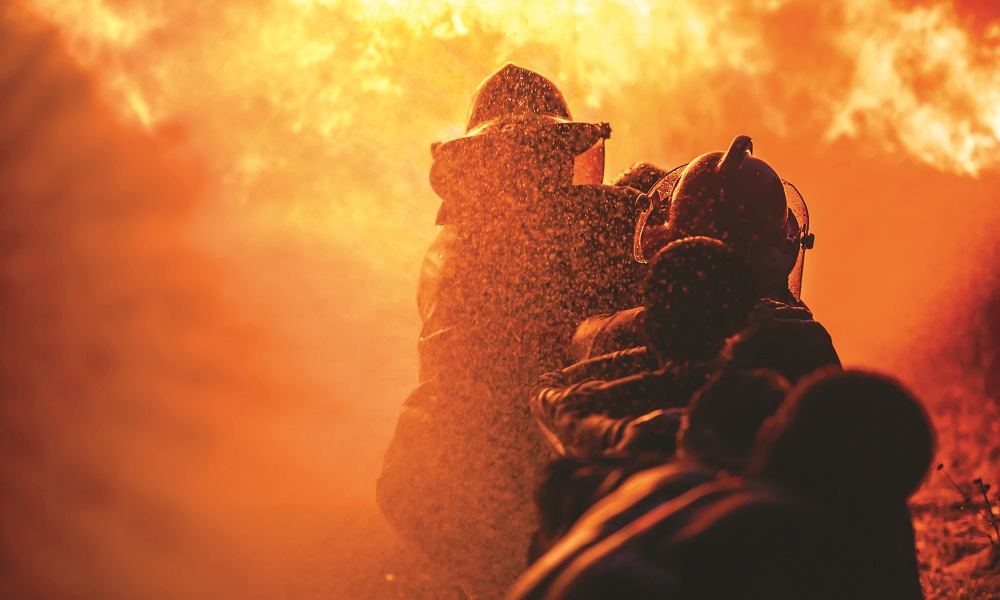Addressing Fire Safety – Kingspan Insulation’s Andrew Pack interview
Kingspan Insulation’s Andrew Pack discusses the region’s fire and safety codes and outlines key findings

Kingspan Insulation produces a variety of products and technology for the built environment and has outfitted some of the region’s most prestigious projects, including the Louvre Abu Dhabi, Dubai International Airport and the King Abdulaziz Centre for World Culture. Andrew Pack, global technical support manager at Kingspan Insulation, provides his insight into fire safety and codes in the UAE.
- Discuss the current fire and safety codes in the UAE, and those specific to the insulation industry in the UAE. How have they affected the market?
Building regulations have evolved tremendously in the Middle East in recent years, including the recent update of the UAE Fire and Life Safety Code. The Fire Code has been in existence since 2011 and references already well established International Fire and Building codes. The chapters relevant to the insulation industry are Chapter 1, Construction, and Chapter 18, Responsibilities of Stakeholders.
Chapter 1 places a strong emphasis on large-scale fire testing of complete wall and façade assemblies. Also detailed in Chapter 1 are the requirements and approvals necessary for insulation products and accessories. Since the recent Fire Code update, we’ve seen an increase in large-scale fire testing and in clients requiring full system approvals. It is important that the UAE Fire and Life Safety Code is kept updated and relevant to the ever changing market, to ensure that new innovations and technology are always considered.
- What can authorities do to ensure structures, especially tall/super tall structures, are well insulated and up to date in terms of fire safety?
Authorities can ensure this through education and enforcement of the UAE Fire and Life Safety Code of Practice with the industry. The recently updated Fire Code, specifically, Chapter 1, Construction, now provides the backbone to compliance for the industry on fire safety of all structures. Authorities can reference Chapter 18, Responsibilities of Stakeholders, to remind all stakeholders of their responsibilities to fire and life safety. This specific chapter highlights the mandatory duties of individual stakeholders in their individual occupancies and their role in supporting and executing the regulations of Civil Defence. Stakeholders mentioned in the chapter include owners, tenants, developers, architects, contractors, manufacturers, consultants and house of expertise.
- Describe the tests in the Fire Code that can be used to ensure that a façade meets Fire Code requirements.
There are many different tests referenced in the Fire Code that can be used to test the fire performance of façade materials and complete wall and façade assemblies. These range from small-scale, medium-scale and large-scale, depending on the application and requirements. I’ve noticed a considerable emphasis on large-scale fire testing of complete wall and façade assemblies in the code.
- Which type of test best ensures that a façade meets requirements?
Trusting in simplistic classifications for materials based on small-scale testing is not the solution to ensuring that a façade meets the Fire Code. The reality is that a whole range of factors affect the fire performance of a façade, including design of cavity barriers, fixings used and cavity width. We must continue to improve our knowledge of how these different elements interact. Even if a façade system is considered to be compliant with the UAE Fire and Life Safety Code, it could contain a surprising quantity of combustible material, hence the importance of large-scale system testing for the full system. As any fire expert knows, even some ‘non-combustibles’ are still capable of burning and, in isolation, are no guarantee of fire safety. Therefore, we recommend that large-scale system testing be always used to test fire performance of facades.
- What are some examples of large-scale fire tests?
NFPA 285:2012 (Standard Fire Test Method for Evaluation of Fire Propagation Characteristics of Exterior Non-Load-Bearing Wall Assemblies Containing Combustible Components), BS 8414-1:2015 (Fire performance of external cladding systems. Test method for non-load-bearing external cladding systems applied to the masonry face of a building) and BS 8414-2:2015 (Fire performance of external cladding systems. Test method for non-load-bearing external cladding systems fixed to and supported by a structural steel frame) are good examples of large scale tests. These are large-scale assembly tests that replicate the wall façade and are designed to measure fire spread.
The tests replicate a fire that starts internally inside a room, breaking out through a window and exposing the external façade to fire. The tests are conducted on the entire system assembly that is intended for use on a building façade. This includes the wall panels, cavities, insulation, panel rails, joints, sealants, seams, fasteners, barriers and other construction details. The UAE Fire and Life Safety Code references NFPA 285 and BS 8414 for wall façades on low-rise, medium-rise, high-rise and super high-rise, and across many different occupancy types ranging from residential to offices and mixed use, including hospitals, schools and malls.
- What are some of the requirements you’re seeing from customers in the UAE and across the GCC with regard to façade and insulation solutions?
I’ve seen a substantial number of requests for improved U-values on facades with thin solutions that are tested in accordance with a large-scale fire test for the complete wall and façade assembly, using high-performance insulation products that offer longevity and durability in application.
- What other regulations for insulation should the industry be aware of?
When looking outside fire regulations, another thing to consider on buildings is thermal performance. Local building regulations and standards set required levels of thermal insulation when carrying out building work for new build or refurbishment projects. Thermal performance is expressed as a U-value. The required U-value depends on the location of the project, type of building – domestic or non-domestic – the application (floor, wall or roof) and the regulations that are in place in the region.
Across the Middle East, regional building regulations are in place that prescribe different U-value requirements for architects, consultants and contractors to adhere to when constructing a building. For Dubai, this is the Al Safat and Dubai Green Building regulations. For Abu Dhabi, this is the Abu Dhabi International Energy Code and Estidama. For Riyadh, this is the draft Saudi Arabian Standard, SASO and, where applicable, ASHRAE Energy Standard 90.1-2013 (for all buildings except low-rise residential buildings) and ASHRAE Energy Standard 90.2-2007 (for low-rise residential buildings). And for Muscat, ASHRAE Energy Standards 90.1 and 90.2 should be considered, as no local standards are in place.
- Where are Kingspan’s solutions in terms of compliance with new regulations in the UAE?
We offer façade solutions in the Middle East market that comply with the latest guidance as per the relevant sections of the appropriate chapter within the UAE Fire and Life Safety Code of Practice. This includes products in our Kingspan Kooltherm wall solutions range – the Kooltherm K5 exterior wall board and the Kooltherm K15 cladding board. They are approved for use by the region’s government entities, including Dubai Central Laboratory and Civil Defence, in the combinations tested.
- Countries in the GCC experience harsh weather for a significant portion of the year. How does Kingspan approach this challenge?
Kingspan Insulation invests in a considerable amount of R&D in its product ranges before bringing a solution to market. The solutions that Kingspan brings to the GCC provide customers with the certainty that the products will perform and remain durable for the lifetime of the assembly into which they are installed. We provide first-class technical service, which is one of the most advanced support services in the industry, offering a full spectrum of advice free of charge for all types of design projects. Services include U-value calculations, condensation and dew point calculations, advice on product selection and product data for all ancillary items and installation and fixing advice.
- Tell us about your product’s sustainable element, in terms of how they are produced and once they are deployed on buildings.
Kingspan Insulation is at the forefront of the low-energy building drive, helping architects, engineers and developers get the most energy-efficient building envelope and building services performance, offering triple benefits of cutting energy use, cutting operational carbon dioxide (CO2) emissions and cutting costs. The Kooltherm core is a 90% (or greater) closed cell structure. Having a closed cell structure provides ultra-low thermal conductivity (lambda value λ).
Additionally, as part of Kingspan’s initiative to be a responsible manufacturer, Kingspan’s products are manufactured with a blowing agent that has zero ozone depletion potential (ODP) and low global warming potential (GWP). We are committed to developing products with the needs of the market, especially when these needs will reduce the impact of the construction industry on the environment.
- Why is this important?
The Montreal Protocol is a protocol that aims to reduce and phase out the use of ozone depleting substances (ODSs), such as CFCs and HCFCs. Article 5 Countries – these include GCC countries – that signed up to the Protocol committed themselves to phasing out the use of halons, CFCs and carbon tetrachloride by 2010. Additionally, Estidama rating systems in Abu Dhabi provide guidance related to CFCs and HCFCs and ODP and GWP. Under the Stewarding Materials section, one credit point is available, provided all thermal insulation used has an ODP of zero and a low GWP. This issue is gaining momentum, with many of our projects and clients asking for zero ODP and low GWP.
We are committed to supporting local and international initiatives by supplying zero ODP and low GWP insulants and systems verified by global trade associations. Our products provide an easy route to compliance and help combat climate change and ozone depletion for specifiers, engineers and contractors.





